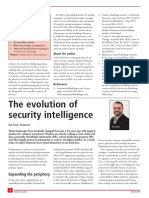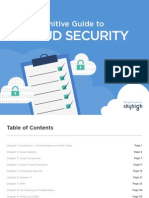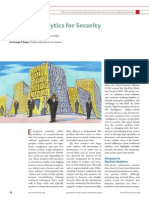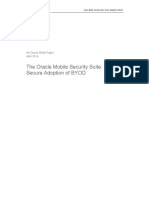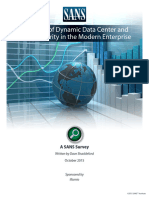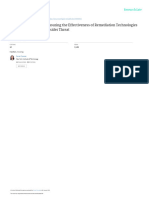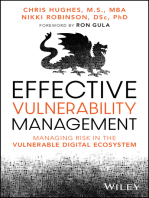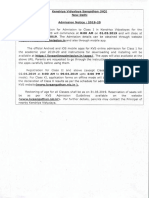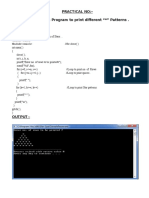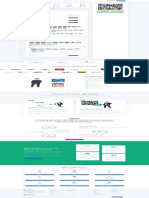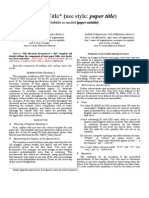Professional Documents
Culture Documents
AI-Driven Proactive Cloud Application Data Access Security
AI-Driven Proactive Cloud Application Data Access Security
Original Title
Copyright
Available Formats
Share this document
Did you find this document useful?
Is this content inappropriate?
Report this DocumentCopyright:
Available Formats
AI-Driven Proactive Cloud Application Data Access Security
AI-Driven Proactive Cloud Application Data Access Security
Copyright:
Available Formats
Volume 9, Issue 4, April – 2024 International Journal of Innovative Science and Research Technology
ISSN No:-2456-2165 https://doi.org/10.38124/ijisrt/IJISRT24APR957
AI-Driven Proactive Cloud Application
Data Access Security
Priyanka Neelakrishnan
Independent Researcher and Product Innovation Expert,
Coimbatore, India
Abstract:- The widespread adoption of cloud I. INTRODUCTION
applications, accelerated by remote work demands,
introduces new security challenges. Traditional In recent years, the explosion of cloud applications and
approaches struggle to keep pace with the growing their adoption by organizations for business continuityhas
volume of cloud applications, keeping track of their user become evident. However, this trend also brings a dark side
activities and countering potential threats. This paper where organizations lack visibility into how data in these
proposes a novel user access security system for cloud cloud applications is stored and accessed by their
applications. The system leverages user activity tracking employees, particularly as remote work becomes more
tied to user, device, and contextual identity data. By prevalent for various reasons. One challenge lies in
incorporating Identity Provider (IdP) information, visibility, while another lies in controlling access. Without
Natural Language Processing (NLP), and Machine adequate visibility, controlling access becomes impossible.
Learning algorithms (ML), the system builds user
baselines and tracks deviations to bubble up critical Another pain point that organizations face stems from
deviations to the surface and proactively prevent further the large number of incidents generated by their legacy
worsening in real-time, working in conjunction with security solutions. Incident remediators often struggle to
security orchestration, automation, and response triage these incidents, and the lack of evidential data further
(SOAR) tools. Deviations from the baselines, which may complicates forensic analysis. As a result, data breaches
indicate compromised accounts or malicious intent, may go unnoticed and become difficult to prove.
trigger proactive interventions. This approach offers
organizations superior visibility and control over their Traditional cloud application data protection security
cloud applications, enabling proactive and real-time solutions typically rely on security policies authored by
threat detection and data breach prevention. While real- cloud administrators, which specify various criteria.
time data collection from application vendors remains a Incidents are generated when these criteria are violated.
challenge, near-real-time is made feasible today. The However, a significant flaw in this approach is that there is
system can also effectively utilize IdP logs, activity logs no one-size-fits-all policy, and it's challenging to add or
from proxies, or firewalls. This research addresses the remove inclusions and exclusions from already complex
critical need for proactive security measures in the policies. Consequently, critical violations may go unnoticed,
dynamic landscape of cloud application data security. leading to data breaches. Moreover, the sheer volume of
The system will need a quarter (90 days) of learning time incidents generated in medium and large organizations on a
to ensure accurate detections based on historically daily basis often leaves them unserviced for months. Even
gathered data and protect them for future baseline when incidents are addressed, challenges such as
predictions on the user themselves and as well as on their insufficient forensic evidence, numerous low-priority
peers. This approach ensures the detection is incidents escalating to critical ones, and a lack of contextual
contextually aware of the organization as a whole. This understanding persist.
research completely redefines traditional thinking with
decentralized intelligence across the system that has a All these issues pose a serious threat to organizations,
highly scalable microservice architecture. The proposed making it difficult for them to confidently allow their
solution is a uniquely intelligent system where both employees to use cloud applications for processing sensitive
human and artificial intelligence coexist, with the and confidential data.
ultimate overriding control lying with humans (admin).
This way, the outcomes at every stage are effective, The main objective of this paper is to provide guidance
making the overall detection and proactive security and demonstrate that it is possible to implement a robust
effective. cloud data security system that proactively protects
organizational data in cloud applications while encouraging
Keywords:- Data Protection; User; Peers; Organization; employee productivity.
Machine Learning; Aggregator; Cloud Application Security.
IJISRT24APR957 www.ijisrt.com 510
Volume 9, Issue 4, April – 2024 International Journal of Innovative Science and Research Technology
ISSN No:-2456-2165 https://doi.org/10.38124/ijisrt/IJISRT24APR957
This paper aims to develop a novel system that with GDPR requirements, and it took several months for
leverages human and artificial intelligence for data Marriott to discover the data breach.
aggregation, correlation, context and intent derivation, and
consolidation of point solutions to effectively address the In the Twitter Bitcoin Scam of July 2020, hackers
core purpose of cloud application data protection. gained access to administrative tools via compromised
credentials of Twitter employees and posted scam messages
II. LITERATURE AND BACKGROUND SURVEY from 130 private and corporate high-profile Twitter
accounts [11], resulting in the transfer of $180,000 in
Insider threats and attacks are on the rise. Sixty-eight bitcoins to scamming accounts.
percent of organizations have observed an increase in
insider threats over the past 12 months [1], and forty-nine The Zola Hack in May 2022 involved hackers using an
percent of organizations can’t detect these threats. Even if age-old attack technique known as credential stuffing to
detected, it’s often difficult, if not impossible, to prove due breach the popular wedding planning site, Zola [12]. This
to a lack of proper forensics [2]. Compromised cloud resulted in fraudulent activity tied to customer accounts
accounts cost companies an average of $6.2 million each [13], with approximately 3,000 accounts compromised. As
year and lead to 138 hours of application downtime [3]. part of their remediation efforts, Zola temporarily disabled
Notably, sixty-two percent of data breaches are attributed to mobile apps connected to the platform, causing business
leveraged credentials, according to the Verizon Data Breach slowdowns and requiring urgent remediation efforts.
Investigation Report [4]. It takes an average of 287 days for
an organization to identify a data breach, with the average III. EXISTING SYSTEM AND UNIQUENESS OF
cost amounting to $3.86 million [5]. Types of users that THE PROPOSED SYSTEM
pose a risk include disgruntled employees, outgoing
employees, accidental exposures, corporate spies, and Existing User Entity Behavioral Analytics (UEBA)
fraudsters. Solutions in the Market and Academic Research [14]
Lack in Four Critical High-Level Areas:
My research on the OpenDaylight Software Defined
Network (SDN) controller, conducted in 2016 [6], aimed to It’s always hard to create a baseline due to data
improve the scalability of the architecture through corruption and lack of user data and its aggregation.
microservices running on different instances of the Even when this challenge is addressed, there are the next
controller. This research provided valuable insights for the layer of challenges. The data feed is not rich enough to
current study. Based on the findings in SDN microservice correlate the user activity across multiple applications
scaling architecture, we could employ a user activity and multiple instances of the same application. This is
microservice for a specific user across cloud application where my previous SDN research [6] helps our current
instances. This approach allows us to holistically gather user research to consolidate the data by having a specific user
activities across different applications, providing a data service run in different instances across
sophisticated user data feed and an intelligent analytic applications. Artificial intelligence (AI) technologies like
analyzer that scales both horizontally and vertically. The natural language processing and generative AI models
novel software microservice-based architecture mentioned are used to quickly connect and grasp the intent and
in the SDN research [6] significantly influenced the context of the user holistically.
architecture of the proposed cloud AI-driven data security The analytics engine is not sophisticated enough to
system. accurately compare the user activity among themselves
and across their peers at the same given time stamp.
Several real-world case studies prompted the need for Here is where our proposed system is unique. It uses
this research, leading to the development of this paper. machine learning (ML) models to train the user data in
relation to peer data to establish a baseline, along with
In the General Electric’s Malicious Insider Case of attaching a baseline deviation score to each user action
2020, a couple of GE employees were convicted of stealing for predictions. The covalent machine learning model,
trade secrets to gain a business advantage [7]. Thousands of which has the user and peer score attached, encompasses
files were downloaded by the employees before leaving the multiple inner models like probabilistic models and
organization, without the knowledge of the GE location models that vertically scale on-demand to
cybersecurity team. It took GE several years to discover and effectively analyze and assign the activity deviation
convict them [8], and even then, proving the case took years scores. Additionally, our proposed solution also
due to a lack of forensics. incorporates feedback from the admin or traditional
policy-based services to train the ML model to
The Marriott Data Breach Case in January 2020 proactively adapt its detections.
involved hackers gaining access to a third-party application Once existing UEBA solutions provide anomalous
through compromised credentials [9], resulting in access to scores, they do not limit and are mostly used for
Marriott guest lists containing sensitive PII information informational visibility purposes. Here, with our
[10]. Marriott was fined £18.4 million for non-compliance proposed system, we provide information for visibility
and simultaneously take real-time action to adjust
IJISRT24APR957 www.ijisrt.com 511
Volume 9, Issue 4, April – 2024 International Journal of Innovative Science and Research Technology
ISSN No:-2456-2165 https://doi.org/10.38124/ijisrt/IJISRT24APR957
privilege permissions for suspicious users and send saving them triaging time. This approach eliminates the
notifications to the admin and suspicious end-users via burden on the admin while allowing them to retain
email and real-time system-generated "on-the-fly Policy" overall approval/disapproval authority.
logged in the existing policy lists. When the notification In a traditional system, there is only one analytic engine
reaches the admin in real-time, they have the option to that is intelligent with a basic ML model or rule-based
override the system-provided "on-the-fly Policy" back to model. This engine forms the core of the UEBA system.
its previous state. This approach allows malicious users However, in our proposed system, the intelligence of the
to be prevented from certain access or activities without detection engine is decentralized, making every service
blocking productivity. In the future, suspicious end-users from the ground up autonomous to enable smart work
and their managers could also be added to the for a fully intelligent system.
notification service, and the manager could be given a
justification option submitted to the admin to allow for Overall, we have established that the proposed solution
one of several scenarios in a decentralized manner, is one-of-a-kind and has been proposed for the first time.
Fig 1: AI-Driven Data Access Security System
IV. PROPOSED SYSTEM ARCHITECTURE Activity feeder plane
Aggregator plane
The proposed system is architecturally classified into Analytics engine plane
four horizontal planes. In the proposed model, the Action driver plane.
intelligence of the data processor is decentralized across all
the planes, unlike traditional single intelligent UEBA There are several services running in each of these
analytic engines. This way, the system becomes fully planes that scale both vertically and horizontally on-demand
autonomous and ready for smart work from the ground up. to avoid performance degradation during load. The services
themselves shut down and turn on as per the servicing
application and user traffic data. All of the microservices in
the system scale horizontally and vertically on-demand.
Fig 2: Automatic System Architecture
IJISRT24APR957 www.ijisrt.com 512
Volume 9, Issue 4, April – 2024 International Journal of Innovative Science and Research Technology
ISSN No:-2456-2165 https://doi.org/10.38124/ijisrt/IJISRT24APR957
A. Activity Feeder Plane V. METHODOLOGY
The activity feeder plane is responsible for collecting
and providing a rich data feed of the user, device, The solution runs for a solid 90 days (typically from
application, identity provider services, proxy or firewall, and the beginning of the quarter), collecting all the activities
cloud application vendor logs to the aggregator in their surrounding the entities. This ensures that unique activities
respective formats. Each entity has a service of its own that occurring at the end of the quarter are not missed.
scales, for example: user service, application service. Inside
that parent service, there are child services to support multi- In the first stage, which involves services in the
tenancy, such as device service, cloud Azure service, Okta activity feeder plane, smart microservices are trained to
service, proxy service, file manager service, file activity collect all the activities by tracking every entity along with
type service, resource creator tracker service, sensitive data the corresponding timestamps. The entities of interest
snippet service, and malware file identifier service. There is include:
a common “Time manager service” based on a large
language model (LLM) and natural language processing User
(NLP) that collects data from each service to associate the Files/Folders
outputs together based on the timestamp and funnel them to Application
the Activity aggregator service. Application Instances
Sensitive Data Snippets
B. Activity Aggregator Plane Malware Details
The activity aggregator plane is responsible for the Account Details, Including Service Accounts
overall mapping to draw the user 360 associations. Key Identity Provider Logs
mapper microservices are run in this plane, including Identity Provider Sync (Azure Ad, Okta)
user:device mapper, user:application mapper and its child Device Details
service user:app instance mapper, user:location mapper, All Possible Logs From Cloud Application Vendors And
user:sensitive data snippet mapper, user: malware file Proxies.
mapper, user:file activity type mapper, and user:resource
creator tracker mapper. There is a common “Job manager The primary focus in this stage is the user and the
service” that unifies the details from the output of each of user’s interaction with all related entities. Every activity
the services to create a user and entity 360 graph with all the related to the user is thoroughly captured for processing.
user activities and their associated entities aggregated. Smart AI technologies then act on this data and create time-
based event correlations.
C. Analytics Engine Plane
The analytics engine plane is responsible for creating a In the second stage, the aggregator plane receives the
holistic user profile with hierarchy and peer profile mapper. time-correlated event logs for the entities and begins
Services like comparator, active directory hierarchy creating the user:entity mapper in the respective
collector, deviation score assigner, further probability microservices. The result of this processing is to create a
predictor, user graph enhancer, feedback collector, feedback mapper table for user interaction and to follow the data in
disperser, on-the-fly policy enforcer, notifier, and admin on- addition to the user. A consolidated user and entity graph is
the-fly policy overrider are included in this plane. The created as the output, enabling the system to track data from
analytics engine plane outputs the user risk score, entity risk its origination. This operation enhances forensics and
score, on-the-fly policy recommendations, notifications, and enables proactive security.
a forensics trail with the incident log. The entity risk score
here refers to application risk scores, file risk scores, file In the third stage, the analytics engine plane receives
activity type risk scores, device risk scores, the entity graphs and uses AD sync information to finalize
department/division risk score, role-based risk scores, and the user profile with respect to their position in the
region risk scores. organization. User role, department, region, group, and peer
information, along with their corresponding activities at the
D. Action Driver Plane same given time, are compared. This results in:
The action driver plane is responsible for taking
actions after the detailed visibility provided by the analytics Granular user profile
engine plane. The services in this plane include on-the-fly User and entity risk scores, comparing the user to
policy service, incident forensic viewer, and external themselves, peers, and entities
integrations like security orchestration, automation and Evidence content for forensics
response (SOAR) system or just APIs. Bi-directional Incidents with severity
communication is involved in case of response actions and On-the-fly policy recommendations.
workflows. In the future, there is potential for generating
reports and having them accessible via APIs in this plane. Feedback from humans (admins) is analyzed by the
This plane is also responsible for notifying suspicious end feedback analyzer to ensure the system's accuracy and
users, their managers and admins, and managing practicality. The merge of human and system intelligence
justification approval workflows. ensures control over scoring and detection by humans
IJISRT24APR957 www.ijisrt.com 513
Volume 9, Issue 4, April – 2024 International Journal of Innovative Science and Research Technology
ISSN No:-2456-2165 https://doi.org/10.38124/ijisrt/IJISRT24APR957
(admins). Risk is calculated based on deviations detected in The User/Entity Risk Model Includes:
a user/entity's normal behavior pattern. An overall risk
score, its corresponding range, and rank are computed for a Risk Range: Critical, High, Medium, Low, Info level
user/entity based on various types of suspicious activity User/Entity Risk Score: (0-100)%
incidents. Risk Rank: user rank/number of employees in the
organization
Peer Risk Score: (0-100)%.
Risk scores are computed in a human-understandable
percentage format (0-100)%, with risk range categorization
for plain English interpretation.
Fig 3: Key Outcomes from Analytics Engine Plane
In the fourth stage, the action driver plane is and Box, later uploading them to their personal Google
responsible for taking control actions based on the visibility Drive from a managed device.
and recommendations provided by the analytics engine Admin gets notified of suspicious user activities - By
plane. This is where the response actions, involving write- having both the employee's profile and their group, the
to-left communication in the system, are initiated. For normalcy-deviation detector (without any policies)
instance, once a policy is enforced, the notification of the tracks activities across corporate applications and flags
incident is sent to the suspicious end user, their manager, the user as suspicious, thereby identifying malicious
with the option to provide justification, and the admin to insiders.
approve or revoke the on-the-fly policy in real-time. Multiple devices using the same credentials to access
corporate apps - Several employees from the same
Here are Some of the Key Use Cases the System department and region access Salesforce corporate
Effectively Addresses. applications using the credentials of the same local
account.
Potential Attacker Identification - As a cloud admin, I’d Manager gets notified of compromised account - Having
like to detect and prevent potential attacks to ensure our device-to-user mapping, the normalcy-deviation detector
organization's data in the cloud remains secure. (without any preset policies) tracks Salesforce
User Access Privilege Misuse Identification - As a cloud application access from different devices using the same
admin, I’d like to identify and stop unnecessary local account and flags this as a compromised account.
privileges given to certain users and restore them to their The manager of the group gets notified, necessitating
peer norms. them to deprovision the account to mitigate potential
Malicious insider stealing data from multiple corporate risks.
applications - An employee exfiltrates data by Malicious data accesses go undetected - Employees use
downloading a large number of files from Google Drive their valid credentials to exfiltrate data; ex-employees
IJISRT24APR957 www.ijisrt.com 514
Volume 9, Issue 4, April – 2024 International Journal of Innovative Science and Research Technology
ISSN No:-2456-2165 https://doi.org/10.38124/ijisrt/IJISRT24APR957
still use unprovisioned accounts to gain access; attackers A. Compromised Accounts (Credential Theft):
use valid user accounts to access corporate applications.
Visibility to admin - Risk score-based top risky users - Local Accounts - Several employees from the same
ML-driven analytics engine tracks user activities across department and region access the Salesforce corporate
all SaaS applications. Based on this, every user in the application using the credentials of the same local
organization receives a risk score indicating their risk to account. Leaving loose ends would mean the employee,
the organization. The admin gains visibility on top risky even after leaving the organization, could access that
users, and policy recommendations are provided to local account with the known shared credentials.
monitor the risky users accessing applications, which the Is Uma really Uma? - Uma usually accesses the Box
admin can enforce in a single click. application from San Jose, California, between the hours
Remote employee accesses corporate data - An of 8 am and 6 pm. A hacker, who claims to be Uma, with
employee accesses corporate applications from a new her stolen credentials accesses the same Box application
remote location using their managed device. from a different location (never accessed by Uma from
Instant incident remediation with SOAR - The this location based on her past history) at an unusual
behavioral analytics engine flags the user as suspicious. time.
SaaS security directly integrated with SOAR
automatically executes a playbook to notify both the B. Privilege Misuse (Privileged User Threats):
employee and their manager about this incident. The
manager remediates the incident by providing a response Activity Type - Losh, who is part of the HR
action as a false positive with justification that the user organization, usually can view the salary data of all
has moved to this new remote location. employees. She also has the additional privilege to copy.
Malware attacker goes unrestrained - An employee Losh copies the salary information of select employees
continuously uploads malware files to a corporate in the Sales organization, differing from the behavior of
application. The system immediately blocks the attacker her peers.
and enables the admin for future decisions. The analytics Application Access - Neela from the engineering
engine has already flagged this user as “high” risk. division has access to all corporate applications in the
Additionally, the engine notifies this specific user organization. One fine day, Neela accesses the
uploading malware content to the corporate application, Salesforce application to view the quarterly report,
makes a policy recommendation, and enforces blocking differing from her peers in the engineering department.
the user from further accessing that corporate app. The
admin reviews this enforcement and allows or revokes C. Data Exfiltration (Data Theft):
this policy in a single click. Bulk Activity - Pranesh has tendered his resignation.
Now, Pranesh downloads marketing documents from
VI. IMPLEMENTATION AND RESULTS different corporate applications, which is unusual behavior
compared to his baseline behavior. He intends to use this
The overall system implementation is done using the information in his next job.
Java programming language, and machine learning models,
largelanguage models, and natural language processing are D. Sensitive Data Exfiltration (Data Breaches):
used across the system, working and interacting along with
the databases and the microservices. These models utilize a Extensive Sensitive Data Access -Viji, who is a Bank
range of methodologies starting with probability manager, downloads all customer PII data from
distribution, neural networks, and feedback correlator, and corporate GDrive.
subsequent decorrelator to ensure the models are more Broader Sensitive Data Access - Perumal is an employee
robust and accurate. Following are the key scenarios for in the HR department who, as part of his job duties, had
testing: to access employees' SSN. Suddenly, we see Perumal
accessing the source code and HIPAA content. This is a
deviation from his usual sensitive content access, which
is SSN.
The system creates entity details, which are the
outcomes of the analytics engine plane. Figure 4 illustrates
the fundamentals of user details, which also stack ranks the
entity with respect to their peers. Figure 5 showcases how
the incidents change over time as the system learns and
adapts the detection.
IJISRT24APR957 www.ijisrt.com 515
Volume 9, Issue 4, April – 2024 International Journal of Innovative Science and Research Technology
ISSN No:-2456-2165 https://doi.org/10.38124/ijisrt/IJISRT24APR957
Fig 4: User/Entity Details
Fig 5: Incident Trend over a Time Period
IJISRT24APR957 www.ijisrt.com 516
Volume 9, Issue 4, April – 2024 International Journal of Innovative Science and Research Technology
ISSN No:-2456-2165 https://doi.org/10.38124/ijisrt/IJISRT24APR957
Key Outcomes of the System are as Follows:
File Count Deviation - Data Exfiltration/Suspicious Data Activity Type, Current File Counts, Expected Value,
Access (Volume Deviation) - App Instance Name, Risk Score, View Log.
Fig 6: User Activity Table for Data Access
Fig 7: User and Peer Comparison Graphs for Data Access
File Activity Type Deviation - Privilege Applications Deviation) - App Instance Name, Current
Misuse/Suspicious Activity Type Access and Suspicious Activity Types/Applications Value, Expected Value,
Application Access (Activity Type Deviation, Risk Score.
Fig 8: User Activity Table for Activity Type Access
IJISRT24APR957 www.ijisrt.com 517
Volume 9, Issue 4, April – 2024 International Journal of Innovative Science and Research Technology
ISSN No:-2456-2165 https://doi.org/10.38124/ijisrt/IJISRT24APR957
Fig 9: User and Peer Comparison Graphs for Activity Type Access
Application Access Deviation - Privilege Applications Deviation) - App Instance Name, Current
Misuse/Suspicious Activity Type Access and Suspicious Activity Types/Applications Value, Expected Value,
Application Access (Activity Type Deviation, Risk Score.
Fig 10: User Activity Table for Application Access
Fig 11: User and Peer Comparison Graphs for Application Access
IJISRT24APR957 www.ijisrt.com 518
Volume 9, Issue 4, April – 2024 International Journal of Innovative Science and Research Technology
ISSN No:-2456-2165 https://doi.org/10.38124/ijisrt/IJISRT24APR957
Location and Time Deviation - Compromised Current Value (Time, Location, Device), Expected
Account/Suspicious Logins (Time Deviation, Location Value, Risk Score, View Logs.
Deviation, Device Deviation) - App Instance Name,
Fig 12: User Activity Table for Time and Location Access
Fig 13: User and Peer Comparison Graphs for Time and Location Access
Sensitive Data Access Deviation - Sensitive Data Type, Current Value (Files/Messages/Entity), Expected
Exfiltration/Suspicious Sensitive Content Access (Data Value, Risk Score, View Log (this will include Time,
Patterns and Profiles) - App Instance Name, Activity Location, File/Entity Name, Sensitive Data Content).
Fig 14: User Activity Table for Sensitive Data Access
IJISRT24APR957 www.ijisrt.com 519
Volume 9, Issue 4, April – 2024 International Journal of Innovative Science and Research Technology
ISSN No:-2456-2165 https://doi.org/10.38124/ijisrt/IJISRT24APR957
Fig 15: User and Peer Comparison Graphs for Sensitive Data Access
VII. CONCLUSION REFERENCES
In summary, the findings of this research emphasize [1]. Cybersecurity Insiders, “Insider Threat Report
the importance of implementing robust security protocols to [Gurucul],” [Online]. Available at:
protect organizational data within cloud environments. https://www.cybersecurity-insiders.com/wp-
Through an in-depth examination of various threat content/uploads/2021/06/2021-Insider-Threat-
scenarios, we have underscored the critical need for Report-Gurucul-Final-dd8f5a75.pdf. [Accessed:
proactive detection and mitigation strategies to safeguard May-2022].
against potential breaches. [2]. Pulse and Code 42 Survey report. “Pulse Survey:
47% of Organizations Don’t Properly Monitor
Our proposed system, leveraging advanced Insider Risk Indicators,” [Online]. Available at:
technologies including machine learning models, large https://www.code42.com/resources/infographics/puls
language models, and natural language processing, offers a e-survey-forty-seven-percent-of-organizations-dont-
comprehensive approach to identifying and addressing properly-monitor-insider-risk-indicators. [Accessed:
security risks. By harnessing these methodologies, we May-2022].
enhance the accuracy and efficiency of threat detection, [3]. Ponemon LLC Research report, “The Cost of Cloud
enabling organizations to respond swiftly and effectively to Compromise and Shadow IT,” [Online]. Available at:
potential security incidents. https://www.proofpoint.com/sites/default/files/analys
t-reports/pfpt-us-ar-cost-of-cloud-compromise-and-
Moreover, the system's capability to analyze user shadow-IT.pdf. [Accessed: May-2022].
behavior, application access patterns, and data activity [4]. Verizon business, “2022 Data Breach Investigations
deviations provides administrators with valuable insights Report (DBIR),” [Online]. Available at:
into potential security vulnerabilities. By stack-ranking https://www.verizon.com/business/resources/reports/
entities and providing risk scores, administrators can dbir/. [Accessed: May-2022].
prioritize remediation efforts and allocate resources more [5]. IBM Security, “Cost of a Data Breach
efficiently, thereby strengthening the organization's overall Report,”[Online]. Available at:
security posture. https://www.ibm.com/downloads/cas/RZAX14GX
[Accessed: May-2022].
In conclusion, this research highlights the effectiveness [6]. Priyanka Neelakrishnan, “Enhancing Scalability and
of an integrated approach to cloud data security, combining Performance in Software-Defined Networks: An
advanced technologies with proactive monitoring and OpenDaylight (ODL) Case Study,” in Magnetism,
response mechanisms. By adopting such strategies, vol. III, G.T. Rado and H. Suhl, Eds. New York:
organizations can fortify their defenses against emerging Academic, 1963, pp. 271-350.
threats and mitigate the risks associated with sensitive data [7]. “Famous Insider Threat Cases,” [Online]. Available
access and exfiltration, thus safeguarding the integrity and at: https://gurucul.com/blog/famous-insider-threat-
confidentiality of their valuable assets. cases. [Accessed: June-2022].
[8]. “Trade Secret Theft,” [Online]. Available at:
https://www.fbi.gov/news/stories/two-guilty-in-theft-
of-trade-secrets-from-ge-072920. [Accessed: June-
2022].
IJISRT24APR957 www.ijisrt.com 520
Volume 9, Issue 4, April – 2024 International Journal of Innovative Science and Research Technology
ISSN No:-2456-2165 https://doi.org/10.38124/ijisrt/IJISRT24APR957
[9]. “Real Life Data Breaches caused by Insider Threats,” [12]. “Credential Stuffing,” [Online]. Available at:
[Online]. Available at: https://en.wikipedia.org/wiki/Credential_stuffing.
https://www.ekransystem.com/en/blog/real-life- [Accessed: June-2022].
examples-insider-threat-caused-breaches. [Accessed: [13]. “Wedding Registry site Zola says Customer
June-2022]. Accounts were Hacked,” [Online]. Available at:
[10]. “Marriott International Notifies Guests of Property https://www.nydailynews.com/2022/05/23/wedding-
System Incident,” [Online]. Available at: registry-site-zola-says-customer-accounts-were-
https://news.marriott.com/news/2020/03/31/marriott- hacked/. [Accessed: June-2022].
international-notifies-guests-of-property-system- [14]. JagreetKaur; Kuldeep Kaur; Surya Kant; Sourav
incident. [Accessed: June-2022]. Das,”UEBA with Log Analytics,” IEEE 3rd
[11]. “2020 Twitter account Hijacking,” [Online]. International Conference on Computing, Analytics
Available at: and Networks (ICAN), 2023.
https://en.wikipedia.org/wiki/2020_Twitter_account_
hijacking. [Accessed: June-2022].
PRIYANKA NEELAKRISHNAN, was born on December 20, 1990. She holds a Bachelor of
Engineering degree in Electronics and Communication Engineering from Anna University, Chennai,
Tamil Nadu, India (2012); a Master of Science degree in Electrical Engineering with a focus on
Computer Networks and Network Security from San Jose State University, San Jose, California, United
States (2016); and a Master of Business Administration degree in General Management from San Jose
State University, San Jose, California, United States (2020). Currently, Priyanka works as a Product Line
Manager, Independent Researcher, and Product Innovator, specializing in driving product innovation and
development. Previously, she has held positions as a Senior Product Manager and Senior Software
Development Engineer at reputable cybersecurity firms.
Priyanka Neelakrishnan is also an accomplished author, having penned the book titled “Problem Pioneering: A Product
Manager’s Guide to Crafting Compelling Solutions”. She is currently in the process of writing another book focusing on
cybersecurity.
IJISRT24APR957 www.ijisrt.com 521
You might also like
- Payroll Management Project ProposalDocument3 pagesPayroll Management Project ProposalUmair Yasin100% (4)
- Fault Code: 3326 - SPN: 91 - FMI: 9: ISX15 CM2350 X101Document3 pagesFault Code: 3326 - SPN: 91 - FMI: 9: ISX15 CM2350 X101Wael SalehNo ratings yet
- Technical Manual: KVH DSP-1760 Multi-Axis GyroscopeDocument111 pagesTechnical Manual: KVH DSP-1760 Multi-Axis GyroscopeNT0% (1)
- The Unsolved Opportunities For Cybersecurity ProvidersDocument6 pagesThe Unsolved Opportunities For Cybersecurity ProvidersMohamed TaufiqhNo ratings yet
- Csol 500 WKDocument14 pagesCsol 500 WKapi-651266391No ratings yet
- Ijet V3i4p1Document5 pagesIjet V3i4p1International Journal of Engineering and TechniquesNo ratings yet
- Cyber SecurityDocument7 pagesCyber SecurityVINCENT MUHARINo ratings yet
- Leveraging The Cloud WPDocument15 pagesLeveraging The Cloud WPdropboxNo ratings yet
- Security and Privacy - A Big Concern in Big Data A Case Study On Tracking and Monitoring SystemDocument4 pagesSecurity and Privacy - A Big Concern in Big Data A Case Study On Tracking and Monitoring SystemabswaronNo ratings yet
- Implementing Application in BYOD Environment To Gain Secure Access To Organization ResourcesDocument6 pagesImplementing Application in BYOD Environment To Gain Secure Access To Organization ResourcesInternational Journal of Innovative Science and Research TechnologyNo ratings yet
- IDC Report 2019Document7 pagesIDC Report 2019Julie SmithNo ratings yet
- Monitoring Security in Cloud Environments: Rep RtsDocument13 pagesMonitoring Security in Cloud Environments: Rep RtsAlex NicolițaNo ratings yet
- Research Papers On Information Systems SecurityDocument5 pagesResearch Papers On Information Systems Securityc9rvz6mm100% (1)
- Cates-2015-The Evolution of Security Intellige PDFDocument3 pagesCates-2015-The Evolution of Security Intellige PDFArmando Rafael Fonseca ZuritaNo ratings yet
- IT Security and Risk ManagementDocument10 pagesIT Security and Risk ManagementNikhil GangwarNo ratings yet
- Cybersecurity Tools For IS Auditing: October 2018Document8 pagesCybersecurity Tools For IS Auditing: October 2018Harisolo AndriamahadyNo ratings yet
- PGD/MSC Cyb - Jan20O - Cloud Security - Terminal Assignment Based AssessmentDocument22 pagesPGD/MSC Cyb - Jan20O - Cloud Security - Terminal Assignment Based Assessmentmounika kNo ratings yet
- Cloud Computing and SecurityDocument4 pagesCloud Computing and SecurityInternational Journal of Innovative Science and Research Technology100% (1)
- Identity Access Management (IAM), Privilege Access Management (PAM) & Security Operation Center (SOC)Document9 pagesIdentity Access Management (IAM), Privilege Access Management (PAM) & Security Operation Center (SOC)IJRASETPublicationsNo ratings yet
- Step 8: Policy Revisions Evaluation: Name of Student: Course: Institution: Date of SubmissionDocument12 pagesStep 8: Policy Revisions Evaluation: Name of Student: Course: Institution: Date of SubmissionsamwiseNo ratings yet
- Secure Data Storage and Sharing Techniques For Data Protection in Cloud Environments: A Systematic Review, Analysis, and Future DirectionsDocument31 pagesSecure Data Storage and Sharing Techniques For Data Protection in Cloud Environments: A Systematic Review, Analysis, and Future DirectionsVaNo ratings yet
- Ebook Definitive Guide To Cloud SecurityDocument43 pagesEbook Definitive Guide To Cloud SecurityqaiumNo ratings yet
- Cloud Computing Security FrameworkDocument6 pagesCloud Computing Security FrameworkEditor IJRITCCNo ratings yet
- Emerging Trends in Data Security For Better EnvironmentDocument6 pagesEmerging Trends in Data Security For Better EnvironmentIJRASETPublicationsNo ratings yet
- Paper 110-Toward A Holistic Efficient Stacking Ensemble Intrusion Detection SystemDocument14 pagesPaper 110-Toward A Holistic Efficient Stacking Ensemble Intrusion Detection SystemHakan DemirNo ratings yet
- Big Data Analytics For SecurityDocument3 pagesBig Data Analytics For SecurityDinesh AnbumaniNo ratings yet
- Applsci 13 00259 v2Document19 pagesApplsci 13 00259 v2Tanishi GuptaNo ratings yet
- Modeling and Predicting Cyber Hacking Breaches: Ranjit Patnaik Sekharamantri, Avinash GrandhiDocument4 pagesModeling and Predicting Cyber Hacking Breaches: Ranjit Patnaik Sekharamantri, Avinash Grandhi19RH1AO544No ratings yet
- Seminar FogDocument6 pagesSeminar FogMr. KNo ratings yet
- A Machine Learning Framework For Cybersecurity OperationsDocument5 pagesA Machine Learning Framework For Cybersecurity OperationsInternational Journal of Innovative Science and Research TechnologyNo ratings yet
- Ebook CyberSecurityDocument14 pagesEbook CyberSecurityharvinder singhNo ratings yet
- Digital Forensics in Cyber Security-Recent Trends, Threats, and OpportunitiesDocument14 pagesDigital Forensics in Cyber Security-Recent Trends, Threats, and OpportunitiesykNo ratings yet
- 3736 GUI Cybersecurity TrendsDocument14 pages3736 GUI Cybersecurity TrendsNatnael TafesseNo ratings yet
- An Intrusion Detection System Using Singular Average Dependency Estimator in Data MiningDocument7 pagesAn Intrusion Detection System Using Singular Average Dependency Estimator in Data MiningEditor IJTSRDNo ratings yet
- 4 Lessons of Security Leaders For 2022Document8 pages4 Lessons of Security Leaders For 2022Pedro BengalinhaNo ratings yet
- Biggest Cloud Security Blind SpotsDocument6 pagesBiggest Cloud Security Blind SpotsABDUL HAMEEDKHANNo ratings yet
- African Journal of Engineering and Environment Research Vol.4 (2) 2023 - ISSN: 2992-2828Document11 pagesAfrican Journal of Engineering and Environment Research Vol.4 (2) 2023 - ISSN: 2992-2828Omosekeji TimilehinNo ratings yet
- Research Paper On Mobile Data SecurityDocument8 pagesResearch Paper On Mobile Data Securityyjdzpccnd100% (1)
- WP IT Security ReadyFor 2021Document7 pagesWP IT Security ReadyFor 2021RyanNo ratings yet
- Visionary Innovation Leadership: Frost & Sullivan Best Practices AwardDocument10 pagesVisionary Innovation Leadership: Frost & Sullivan Best Practices AwardAparnaNo ratings yet
- Secured Data Lineage Transmission in Malicious Environment: K. IndumathiDocument3 pagesSecured Data Lineage Transmission in Malicious Environment: K. Indumathisnet solutionsNo ratings yet
- Security Challenges of Big Data ComputingDocument8 pagesSecurity Challenges of Big Data ComputingGopala Krishna SriramNo ratings yet
- The Oracle Mobile Security Suite: Secure Adoption of BYOD: An Oracle White Paper April 2014Document9 pagesThe Oracle Mobile Security Suite: Secure Adoption of BYOD: An Oracle White Paper April 2014shoparoundNo ratings yet
- 2023 - Prisma Cloud - THE STATE OF CLOUD-NATIVE SECURITY 2023 REPORTDocument25 pages2023 - Prisma Cloud - THE STATE OF CLOUD-NATIVE SECURITY 2023 REPORTZephyr YuNo ratings yet
- Guide-4 StepsDocument8 pagesGuide-4 StepsAurelio Vázquez AlejoNo ratings yet
- JREASDocument9 pagesJREASJREAS JOURNALNo ratings yet
- Rethinking Security Operations: Creating Clarity Out of ComplexityDocument14 pagesRethinking Security Operations: Creating Clarity Out of ComplexityLuisNo ratings yet
- The Top Five Technical Issues To Address in Industrial Cyber Security - EditedDocument5 pagesThe Top Five Technical Issues To Address in Industrial Cyber Security - EditedSanjana chowdaryNo ratings yet
- Using 20 Monitoring 20 To 20 Vendor 20 ManagmentDocument13 pagesUsing 20 Monitoring 20 To 20 Vendor 20 ManagmentFravinNo ratings yet
- TRƯỜNG-ĐẠI-HỌC-CÔNG-NGHỆDocument38 pagesTRƯỜNG-ĐẠI-HỌC-CÔNG-NGHỆtuananh400295No ratings yet
- Ijramt V4 I6 12Document4 pagesIjramt V4 I6 12Banumathi MNo ratings yet
- Research Paper Topics in Network SecurityDocument5 pagesResearch Paper Topics in Network Securityp1zajywigyd2100% (1)
- Cloud Computing Security ReportDocument3 pagesCloud Computing Security ReportFatin AmirNo ratings yet
- A System Architecture For The Detection of Insider Attacks in Big Data SystemsDocument14 pagesA System Architecture For The Detection of Insider Attacks in Big Data SystemsAbhishek DasNo ratings yet
- Literature Review Cyber SecurityDocument8 pagesLiterature Review Cyber Securityafdtywgdu100% (1)
- Ebook - Cyber Resilience Crash CourseDocument11 pagesEbook - Cyber Resilience Crash Coursephoenix.risesagain143No ratings yet
- Running Head:: Computer Science 1Document9 pagesRunning Head:: Computer Science 1Mahantesh SpNo ratings yet
- The State of Dynamic Data Center and Cloud SecurityDocument22 pagesThe State of Dynamic Data Center and Cloud SecurityKulwinder KaurNo ratings yet
- Managing Shadow IT in 3 StepsDocument14 pagesManaging Shadow IT in 3 Stepsmdicki.setiawanNo ratings yet
- A Complete Guide to Modernizing Your Security Operations Center -15pgDocument15 pagesA Complete Guide to Modernizing Your Security Operations Center -15pgNewReaderNo ratings yet
- EndpointProtection IEEEVersionDocument10 pagesEndpointProtection IEEEVersionfindinngclosureNo ratings yet
- Implementation of a Central Electronic Mail & Filing StructureFrom EverandImplementation of a Central Electronic Mail & Filing StructureNo ratings yet
- Effective Vulnerability Management: Managing Risk in the Vulnerable Digital EcosystemFrom EverandEffective Vulnerability Management: Managing Risk in the Vulnerable Digital EcosystemNo ratings yet
- Solar Based Multilevel Inverter f o r BLDC Motor DriveDocument8 pagesSolar Based Multilevel Inverter f o r BLDC Motor DriveInternational Journal of Innovative Science and Research TechnologyNo ratings yet
- Meta Land: Redefining Virtual Communities through Centralized Governance, Inclusivity and InnovationDocument5 pagesMeta Land: Redefining Virtual Communities through Centralized Governance, Inclusivity and InnovationInternational Journal of Innovative Science and Research TechnologyNo ratings yet
- Skin Disease Detection and Remedial SystemDocument7 pagesSkin Disease Detection and Remedial SystemInternational Journal of Innovative Science and Research TechnologyNo ratings yet
- Exploring the Potential Advantages of Traditional Therapies in Autoimmune Blistering Illnesses: A Comprehensive Review and Analysis, ResearchDocument12 pagesExploring the Potential Advantages of Traditional Therapies in Autoimmune Blistering Illnesses: A Comprehensive Review and Analysis, ResearchInternational Journal of Innovative Science and Research TechnologyNo ratings yet
- Development of Smart Ground Fault Location Model for Radial Distribution SystemDocument14 pagesDevelopment of Smart Ground Fault Location Model for Radial Distribution SystemInternational Journal of Innovative Science and Research TechnologyNo ratings yet
- EmoConnect: Nurturing Trust and Relationship Bonds in Alzheimer’s ConversationsDocument3 pagesEmoConnect: Nurturing Trust and Relationship Bonds in Alzheimer’s ConversationsInternational Journal of Innovative Science and Research TechnologyNo ratings yet
- Unlocking Sentiments: Enhancing IOCL Petrol Pump ExperiencesDocument8 pagesUnlocking Sentiments: Enhancing IOCL Petrol Pump ExperiencesInternational Journal of Innovative Science and Research TechnologyNo ratings yet
- Design and Development of Multi-Featured Medical StretcherDocument4 pagesDesign and Development of Multi-Featured Medical StretcherInternational Journal of Innovative Science and Research TechnologyNo ratings yet
- Seasonal Variation and Distribution Patterns of Endophytic Community in Withania somniferaDocument7 pagesSeasonal Variation and Distribution Patterns of Endophytic Community in Withania somniferaInternational Journal of Innovative Science and Research TechnologyNo ratings yet
- Preparation and Identification of Magnetic Iron Nanoparticle based on a Natural Hydrogel and its Performance in Targeted Drug DeliveryDocument17 pagesPreparation and Identification of Magnetic Iron Nanoparticle based on a Natural Hydrogel and its Performance in Targeted Drug DeliveryInternational Journal of Innovative Science and Research TechnologyNo ratings yet
- Smart and Secure Home with ChatbotDocument9 pagesSmart and Secure Home with ChatbotInternational Journal of Innovative Science and Research TechnologyNo ratings yet
- Exploring the Post-Annealing Influence on Stannous Oxide Thin Films via Chemical Bath Deposition Technique: Unveiling Structural, Optical, and Electrical DynamicsDocument7 pagesExploring the Post-Annealing Influence on Stannous Oxide Thin Films via Chemical Bath Deposition Technique: Unveiling Structural, Optical, and Electrical DynamicsInternational Journal of Innovative Science and Research TechnologyNo ratings yet
- Reading Intervention Through “Brigada Sa Pagbasa”: Viewpoint of Primary Grade TeachersDocument3 pagesReading Intervention Through “Brigada Sa Pagbasa”: Viewpoint of Primary Grade TeachersInternational Journal of Innovative Science and Research TechnologyNo ratings yet
- Application of Game Theory in Solving Urban Water Challenges in Ibadan-North Local Government Area, Oyo State, NigeriaDocument9 pagesApplication of Game Theory in Solving Urban Water Challenges in Ibadan-North Local Government Area, Oyo State, NigeriaInternational Journal of Innovative Science and Research TechnologyNo ratings yet
- On the Development of a Threat Driven Model for Campus NetworkDocument14 pagesOn the Development of a Threat Driven Model for Campus NetworkInternational Journal of Innovative Science and Research TechnologyNo ratings yet
- Firm Size as a Mediator between Inventory Management Andperformance of Nigerian CompaniesDocument8 pagesFirm Size as a Mediator between Inventory Management Andperformance of Nigerian CompaniesInternational Journal of Innovative Science and Research TechnologyNo ratings yet
- Global Warming Reduction Proposal AssessmentDocument6 pagesGlobal Warming Reduction Proposal AssessmentInternational Journal of Innovative Science and Research TechnologyNo ratings yet
- Application of Plant Growth Promoting Rhizobacteria on Vegetative Growth in Chili Plants (Capsicum frutescens L.)Document7 pagesApplication of Plant Growth Promoting Rhizobacteria on Vegetative Growth in Chili Plants (Capsicum frutescens L.)International Journal of Innovative Science and Research TechnologyNo ratings yet
- A Study to Assess the Knowledge Regarding Teratogens Among the Husbands of Antenatal Mother Visiting Obstetrics and Gynecology OPD of Sharda Hospital, Greater Noida, UpDocument5 pagesA Study to Assess the Knowledge Regarding Teratogens Among the Husbands of Antenatal Mother Visiting Obstetrics and Gynecology OPD of Sharda Hospital, Greater Noida, UpInternational Journal of Innovative Science and Research TechnologyNo ratings yet
- PHREEQ C Modelling Tool Application to Determine the Effect of Anions on Speciation of Selected Metals in Water Systems within Kajiado North Constituency in KenyaDocument71 pagesPHREEQ C Modelling Tool Application to Determine the Effect of Anions on Speciation of Selected Metals in Water Systems within Kajiado North Constituency in KenyaInternational Journal of Innovative Science and Research TechnologyNo ratings yet
- The Impact of Music on Orchid plants Growth in Polyhouse EnvironmentsDocument5 pagesThe Impact of Music on Orchid plants Growth in Polyhouse EnvironmentsInternational Journal of Innovative Science and Research Technology100% (1)
- Mandibular Mass Revealing Vesicular Thyroid Carcinoma A Case ReportDocument5 pagesMandibular Mass Revealing Vesicular Thyroid Carcinoma A Case ReportInternational Journal of Innovative Science and Research TechnologyNo ratings yet
- Detection of Phishing WebsitesDocument6 pagesDetection of Phishing WebsitesInternational Journal of Innovative Science and Research TechnologyNo ratings yet
- Consistent Robust Analytical Approach for Outlier Detection in Multivariate Data using Isolation Forest and Local Outlier FactorDocument5 pagesConsistent Robust Analytical Approach for Outlier Detection in Multivariate Data using Isolation Forest and Local Outlier FactorInternational Journal of Innovative Science and Research TechnologyNo ratings yet
- Esophageal Melanoma - A Rare NeoplasmDocument3 pagesEsophageal Melanoma - A Rare NeoplasmInternational Journal of Innovative Science and Research TechnologyNo ratings yet
- Vertical Farming System Based on IoTDocument6 pagesVertical Farming System Based on IoTInternational Journal of Innovative Science and Research TechnologyNo ratings yet
- Sustainable Energy Consumption Analysis through Data Driven InsightsDocument16 pagesSustainable Energy Consumption Analysis through Data Driven InsightsInternational Journal of Innovative Science and Research TechnologyNo ratings yet
- Investigating Non-Newtonian Fluid Behavior in Hydrocyclones Via Computational Fluid DynamicsDocument18 pagesInvestigating Non-Newtonian Fluid Behavior in Hydrocyclones Via Computational Fluid DynamicsInternational Journal of Innovative Science and Research TechnologyNo ratings yet
- Realigning Curriculum to Simplify the Challenges of Multi-Graded Teaching in Government Schools of KarnatakaDocument5 pagesRealigning Curriculum to Simplify the Challenges of Multi-Graded Teaching in Government Schools of KarnatakaInternational Journal of Innovative Science and Research TechnologyNo ratings yet
- Osho Dynamic Meditation; Improved Stress Reduction in Farmer Determine by using Serum Cortisol and EEG (A Qualitative Study Review)Document8 pagesOsho Dynamic Meditation; Improved Stress Reduction in Farmer Determine by using Serum Cortisol and EEG (A Qualitative Study Review)International Journal of Innovative Science and Research TechnologyNo ratings yet
- KVS Admissions 2019Document2 pagesKVS Admissions 2019shivam tiwariNo ratings yet
- Computer Science MCQs - NTS, FPSC Test Questions Preparation - EbookDocument3 pagesComputer Science MCQs - NTS, FPSC Test Questions Preparation - EbookFarhan AsifNo ratings yet
- Coordination and AgreementDocument69 pagesCoordination and Agreementakash pedapaagaNo ratings yet
- Autodock2 4 UserguideDocument48 pagesAutodock2 4 UserguidePowellAbogadoNo ratings yet
- Guna PlanDocument6 pagesGuna Planteferi GetachewNo ratings yet
- Hamming Code 11Document17 pagesHamming Code 11GuruKPO100% (3)
- Real Time Embedded Systems E 626 ADocument2 pagesReal Time Embedded Systems E 626 Aeta100% (1)
- Eset Esa Installation Guide EnuDocument22 pagesEset Esa Installation Guide EnukaikeestevesNo ratings yet
- Uploading Data From Access To SQL ServerDocument12 pagesUploading Data From Access To SQL ServerExpert TutorNo ratings yet
- CODESYS Visualization enDocument15 pagesCODESYS Visualization enAbdelali KhalilNo ratings yet
- VALORANT MBTI - Gaming - Personality Database ™Document1 pageVALORANT MBTI - Gaming - Personality Database ™Teinhdhs HuhuhuNo ratings yet
- 1604 - 1608 1616 - DVR User's Manual V2Document159 pages1604 - 1608 1616 - DVR User's Manual V2Vojislav KojicNo ratings yet
- ANSYS CFD-Post Users GuideDocument392 pagesANSYS CFD-Post Users GuidetonnyNo ratings yet
- Practical No:-AIM: - Write A Program To Print Different " " Patterns - 1. Source CodeDocument5 pagesPractical No:-AIM: - Write A Program To Print Different " " Patterns - 1. Source CodesaliniprabhaNo ratings yet
- Soluciones para La Transformación Digital en El AgroDocument16 pagesSoluciones para La Transformación Digital en El AgroSemana de la Innovación en AméricaNo ratings yet
- Analysis of Software Quality Tools Samsung Galaxy Note 7 Recall CaseDocument11 pagesAnalysis of Software Quality Tools Samsung Galaxy Note 7 Recall CaseJay PanchalNo ratings yet
- Linux On The GoDocument212 pagesLinux On The GoPRIYANSHU SINGHNo ratings yet
- 2019 08 02 CM BME Standard Operating Procedures Zambia 2019Document26 pages2019 08 02 CM BME Standard Operating Procedures Zambia 2019Ng'andu Kayunna DavidNo ratings yet
- Generate Customized QR Codes - QR - IoDocument1 pageGenerate Customized QR Codes - QR - Iorenan kindersNo ratings yet
- Multimedia Course OutlineDocument12 pagesMultimedia Course OutlineRandall CastilloNo ratings yet
- DeadlocksDocument7 pagesDeadlocksShahazadi Armando SamNo ratings yet
- 019761700XDocument345 pages019761700Xalexandre albalustroNo ratings yet
- PipeSOFT2 2011Document2 pagesPipeSOFT2 2011Alfonso R. ReyesNo ratings yet
- Slic 2.1Document3 pagesSlic 2.1Pankaj Singh RawatNo ratings yet
- Paper Title (Use Style: Paper Title) : Subtitle As Needed (Paper Subtitle)Document3 pagesPaper Title (Use Style: Paper Title) : Subtitle As Needed (Paper Subtitle)balajigandhirajanNo ratings yet
- MovingTablesUsingDB6CONV v40Document33 pagesMovingTablesUsingDB6CONV v40tomasini54No ratings yet
- White Paper enDocument15 pagesWhite Paper enFrançooNo ratings yet













